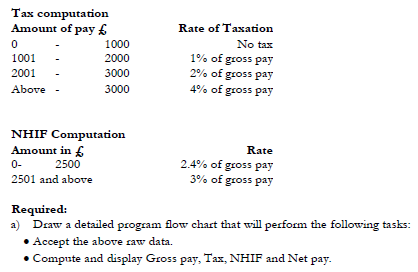
1. Identification of the organization?s assets
This involves taking an inventory of all the organization‘s information security assets e.g. computers, data, personnel, programs, networks, etc
2. Determination of the risks to the assets
For each asset a list of associated risks is produced. For instance, for computers, associated risks include:
- Fire
- Vandalism
- Theft, etc
3. Estimating likelihood of occurrence of each risk
The likelihood of occurrence may be generally classified as high, low or medium.
4. Computation of expected annual losses due to occurrences of the risks.
5. Surveying applicable risk controls and their costs.
6. Selection of appropriate controls
The selection is largely determined by the cost of the control. Where the cost of the control exceeds the estimated loss due to the occurrence of the risk, the control is discarded and an alternative one selected.
7. Projection of annual savings due to the controls
An estimate of the annual cost savings to an organization should be produced with the costs of the controls in mind and the levels of occurrence of the associated risks reduced.
8. Implementation of the risk controls
This should be after management has assessed and approved the selected controls and their cost savings.
9. Review of controls to determine their effectiveness in preventing the occurrence of risks.
10. Implementation of review findings.
Wilfykil answered the question on March 1, 2019 at 10:24
- There are three main types of network topologies namely; star, ring and bus. As a network administrator, you have been asked to produce a briefing...(Solved)
There are three main types of network topologies namely; star, ring and bus. As a network administrator, you have been asked to produce a briefing document that discusses each topology in terms of cabling cost, fault tolerance, data redundancy and performance as the number of nodes increases
Date posted: March 1, 2019. Answers (1)
- There are four major change-over strategies that may be adopted during the implementation phase of information systems development process.(Solved)
There are four major change-over strategies that may be adopted during the implementation phase of information systems development process.
Required:
Recommend and justify the changeover strategies to be adopted for the following systems:
i) Electronic point of sale systems for chains of supermarkets countrywide.
ii) Secondary school admission system.
iii) Airline seat reservation system.
Date posted: March 1, 2019. Answers (1)
- A computer user might buy hardware and software direct from the vendors. Given that the expense is often considerable, the purchasing procedure must be carefully...(Solved)
A computer user might buy hardware and software direct from the vendors. Given that the expense is often considerable, the purchasing procedure must be carefully controlled.
Required:
In a sequential narrative, name and describe the procedure of acquiring hardware and software.
Date posted: March 1, 2019. Answers (1)
- Currently there has been a general trend to consolidate previously separate data centres into larger centres or the move from classic decentralisation as a proliferation...(Solved)
Currently there has been a general trend to consolidate previously separate data centres into larger centres or the move from classic decentralisation as a proliferation of mini data processing departments into centralised information system providers.
Required:
Explain the factors influencing re-centralisation of information systems
Date posted: March 1, 2019. Answers (1)
- What factors should guide a systems designer when designing the user interface for a particular application?(Solved)
What factors should guide a systems designer when designing the user interface for a particular application?
Date posted: March 1, 2019. Answers (1)
- The continuing development and improvement of information technology has revolutionized the accountancy functions in most organisations.(Solved)
The continuing development and improvement of information technology has revolutionized the accountancy functions in most organisations.
Discuss the benefits and dangers of the increasing use of information technologies to the accounting functions in an organisation
Date posted: March 1, 2019. Answers (1)
- The widespread use of computers in offices have raised major health and safety issues.
Describe three major health related problems that may result from intensive computer...(Solved)
The widespread use of computers in offices have raised major health and safety issues.
Describe three major health related problems that may result from intensive computer use and list three products that may be made available to improve the working conditions of personnel using computers
Date posted: March 1, 2019. Answers (1)
- Electronic Commerce (e-commerce) is an emerging concept that describes the buying and selling of products, services and information via the computer networks including the internet.
Required:
a)...(Solved)
Electronic Commerce (e-commerce) is an emerging concept that describes the buying and selling of products, services and information via the computer networks including the internet.
Required:
a) Brief explanation of the following concepts as relates to e-commerce:
i) Electronic market.
ii) Electronic purse.
iii) Cyber banking.
iv) Cyber mall.
Date posted: March 1, 2019. Answers (1)
- What is the purpose of programming standards?(Solved)
What is the purpose of programming standards?
Date posted: March 1, 2019. Answers (1)
- A company is to produce a suite of programs to provide a payroll analysis system. The raw data
for the program input is as follows:
- Pay...(Solved)
A company is to produce a suite of programs to provide a payroll analysis system. The raw data
for the program input is as follows:
- Pay rate
- Hours worked
The logics of how to compute tax and NHIF are shown below.

Date posted: March 1, 2019. Answers (1)
- Organisation information systems are categorised under:
i) Transaction Processing System (TPS)
ii) Management Information Systems (MIS)
iii) Decision Support System (DSS)
iv) Executive Information System (EIS)
v) Expert Systems (ES)(Solved)
Organisation information systems are categorised under:
i) Transaction Processing System (TPS)
ii) Management Information Systems (MIS)
iii) Decision Support System (DSS)
iv) Executive Information System (EIS)
v) Expert Systems (ES)
Required:
Suggest one application of each of the systems types listed above for each of the following functional areas of business:
- Sales and marketing.
- Finance
Date posted: March 1, 2019. Answers (1)
- Explain meaning of the term Electronic Commerce (E-Commerce).(Solved)
Explain meaning of the term Electronic Commerce (E-Commerce).
Date posted: March 1, 2019. Answers (1)
- During the design stage of a new information system, the following issues are addressed:
- User interface.
- Data.
- Process.(Solved)
During the design stage of a new information system, the following issues are addressed:
- User interface.
- Data.
- Process.
Required:
Discuss the composition of design document under the above three elements.
Date posted: March 1, 2019. Answers (1)
- Develop a network diagram and determine the critical path from the following project development schedule.(Solved)
Develop a network diagram and determine the critical path from the following project development schedule.

Date posted: March 1, 2019. Answers (1)
- Explain the term 'critical path as used in project management.(Solved)
Explain the term 'critical path as used in project management.
Date posted: March 1, 2019. Answers (1)
- Structured walk-through addresses some areas of interest in a new program under programming productivity. Explain?(Solved)
Structured walk-through addresses some areas of interest in a new program under programming productivity. Explain?
Date posted: March 1, 2019. Answers (1)
- Explain how the use of Computer Aided Software Engineering (CASE) improves programming productivity.(Solved)
Explain how the use of Computer Aided Software Engineering (CASE) improves programming productivity.
Date posted: March 1, 2019. Answers (1)
- In a sequential narrative, name and describe the main stages in the program development life cycle.(Solved)
In a sequential narrative, name and describe the main stages in the program development life cycle.
Date posted: March 1, 2019. Answers (1)
- The recent desire for closer user participation in new systems development and distribution systems in operations have created more impetus for end user computing technologies.(Solved)
The recent desire for closer user participation in new systems development and distribution systems in operations have created more impetus for end user computing technologies.
Required:
a) Define the term "end user computing'.
b) Identity six risks associated with end user computing.
c) Explain the role of the following in promoting end user computing
(i) Information resource centers.
(ii) Object oriented programming.
Date posted: March 1, 2019. Answers (1)
- The rapid technological revolutions in both computer and management systems have brought in new dimensions in business process engineering and re-engineering.(Solved)
The rapid technological revolutions in both computer and management systems have brought in new dimensions in business process engineering and re-engineering.
Required:
(a) Explain the two terms "process engineering and re-engineering".
(b) Explain the use and application of the following:
(i) Telecommuting.
(ii) Electric data interchange.
(iii) Computer conferencing.
Date posted: March 1, 2019. Answers (1)